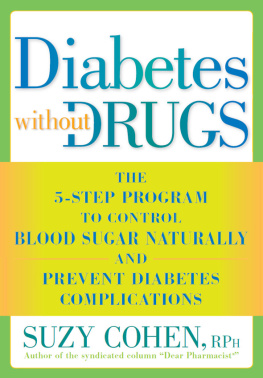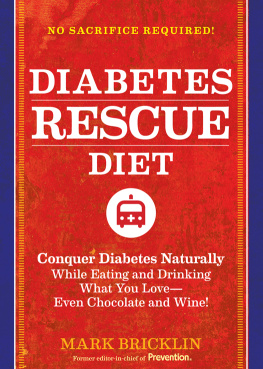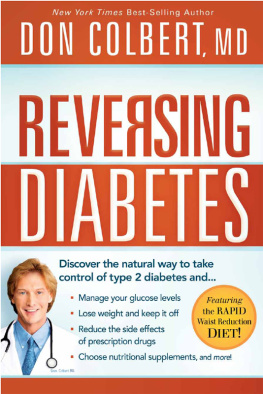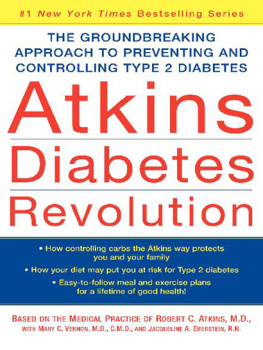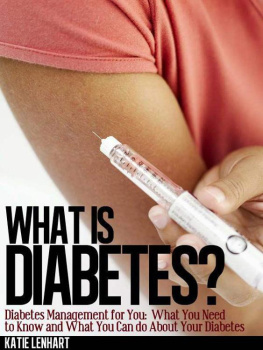
This book is dedicated to my father, Donald M. Barnard, MD, a kind and wise physician, and to the participants in our research studies. I am deeply grateful for your important contribution to this work.
Dr. Barnards solid scientific workrepresents a major turning point in the treatment and outcome of diabetes. Revolutionary in its implications and spectacular in its clarity, this bookwith its simple, safe dietary approachwill bring hope to millions.
HANS DIEHL, DRHSC, MPH, FACN, chairman of the Lifestyle Medicine Institute in Loma Linda, California, and director of the International Nutrition Research Foundation
Dr. Barnards superb book shows us the numerous advantages of following his nutritional program.
WILLIAM C. ROBERTS, MD, editor in chief of the American Journal of Cardiology and executive director of the Baylor Heart and Vascular Institute in Dallas
A promising alternative dietary approach in the treatment of diabetes.
WILLIAM E. CONNOR, MD, professor of medicine and clinical nutrition at Oregon Health and Science University in Portland
CONTENTS
ACKNOWLEDGMENTS
The research that culminated in this book was a team effort. I want to express my deepest appreciation to the research volunteers who put up with many early mornings, late nights, and needlesticks in performing an important public service. You have taught me a great deal and helped this project immeasurably.
I greatly appreciate the support of the National Institute of Diabetes and Digestive and Kidney Diseases of the National Institutes of Health, particularly Sanford Garfield, PhD, and of the Diabetes Action Education and Research Foundation and its director, Pat DeVoe, RN, BSN, without which this research would not have been possible. Thank you to the American Diabetes Association for the opportunity to share our findings along the way.
Joshua Cohen, MD, of the division of endocrinology at George Washington University, was instrumental in planning and guiding our research work. David J. A. Jenkins, MD, PhD, DSc, of the University of Toronto, is an extraordinary mentor whose generosity with his time, knowledge, and ideas is something I hope to pass on to other investigators.
Gabrielle Turner-McGrievy, MS, RD, and Lisa Gloede, RD, CDE, helped extensively in research planning and in guiding our participants toward more healthful ways of eating. Brent Jaster, MD; Amber A. Green, RD; Kim Seidl, MS, RD; Susan Levin, MS, RD; Trulie Ankerberg-Nobis, RD; Dulcie Ward, RD; Jennifer Reilly, RD; and Mary Ellen Wolfe, RN CDE, shared their expertise and guidance with me and our research participants. Robyn Webb and Isabel Clark inspired us all with their culinary wisdom. Thanks to Paul Poppen, PhD, for his expert assistance in planning and executing the statistical analyses. Andrew Nicholson, MD, and Mark Sklar, MD, guided our initial research on diabetes, and Larry Kushi, PhD, provided thoughtful advice along the way. John A. McDougall, MD, and Mary McDougall provided educational materials and wonderful recipes. Jennie Brand-Miller, PhD, of the University of Sydney kindly answered many questions about her studies of the glycemic index and its use in clinical practice.
Stanley Talpers, MD, kept a watchful eye on medical issues for our participants, and Brad Moore, MD, served as our safety officer. Thanks to Tara Nicotra, Beatrice Huang, Melinda Beard, and Walter Gayle for tackling all the day-to-day issues and keeping our research on track.
Thanks also to Cyril Kendall, PhD; Benoit Lamarche, PhD; and Gary Bradwin for their expertise with laboratory analyses. Special thanks to Ernest P. Noble, MD, PhD, and Terry Ritchie, PhD, of the University of California, Los Angeles, for their generosity and expertise in genetic analyses. Thank you to Donald S. Karcher, MD; Terry Costa; Luce Merino; Estela Day; Patrice Moore; and everyone at George Washington University clinical laboratory client services.
Cael Croft provided the wonderful medical illustrations in this book. I am also very grateful to many individuals who made thoughtful comments on the manuscript, especially Caroline Trapp, APRN, BCADM, CDE; Steve Sawmelle; Doug Hall; Stephen Kane; Francelle Wax; Kathy Glissen; Jonathan Balcombe, PhD; Dan Kinburn; Jenn Kaplan; and Benjamin Zoll. Thank you to Lorin OToole for critiquing the manuscript and helping with the recipes.
Finally, and especially, thank you to Mary Ann Naples for endless creativity, enthusiasm, and wise counsel; Lisa Considine, my editor at Rodale, for helping to shape this book into its current form; and Bry-anna Clark Grogan for providing wonderful recipes.
INTRODUCTION
A NEW APPROACH TO DIABETES
This book presents a totally new method for preventing, controlling, and reversing diabetes based on important research findings that have emerged in recent years.
In studies by my research team, funded by the US governments National Institutes of Health and the Diabetes Action Research and Education Foundation, along with the work of other researchers, we have completely redesigned the dietary approach to diabetes. If your experience with diabetes has been one of gradually escalating medication doses, ever-increasing weight, and increasing worry about the risk of complications, you will learn how to reverse those trends.
We will focus on changes in your menu, not on drugs. Yes, medications often have their role, and I will give you details on how they work so you can understand the ones you or your loved ones may be using now. But I would much rather help you scale back on drugsor eliminate them entirely. Doing that means rethinking the foods that you eat.
Let me emphasize that you will not need to cut calories, limit carbohydrates, or stick to small portions. In fact, you can eat until you are full. If you get hungry between meals, you are free to eat more. What we will zero in on is the type of food you eat. That has emerged as the critical factor, as you will soon see.
A NEW IDEA
My father, Donald M. Barnard, MD, spent his entire life treating diabetes. He grew up on a family farm in the Midwest but soon realized that the cattle business was not for him. He decided to go to medical school, and after training at Bostons famed Joslin Clinic, he began work at a busy community hospital. He became known as the diabetes expert for the surrounding area. But he and the other doctorsand their patientsoften found diabetes puzzling and frustrating. He recounted a telling comment made by the clinics founder, Elliott P. Joslin, MD, about diabetes research: Gentlemen, we dont need a big research grant. What we need is a new idea.
Dr. Joslin made that observation back in the 1950s, and the need has only grown more urgent as the incidence of the disease has exploded. Worldwide, about 200 million people are living with diabetes. Until now, most have found the condition to be at best an exercise in drudgery. With daily blood tests and medications that promise only to slow the diseases inevitable damage, a patients life becomes a waiting game, with one complication arising after anotherfrom nerve symptoms to visual changes and heart and kidney problems.
Now, at last, were on the cusp of real change. Im talking not just about a bold new idea, but about an entirely new approach to diabetes that has been tested and proven.
In a series of research studies conducted with Georgetown University and George Washington University in Washington, D.C., our research team has proven that many people with diabetes can think beyond delaying inevitable decline and improve their health dramatically. They can cut their blood sugar, increase insulin sensitivity, and reduce or eliminate medications, and they can do this with a simple set of diet changes. Unlike with medication treatments, the side effects of the menu change are good ones: weight loss, lower cholesterol levels, lower blood pressure, and increased energy.
Next page

